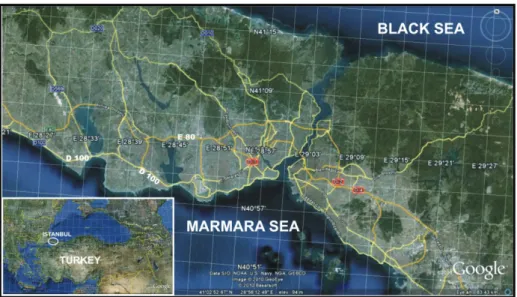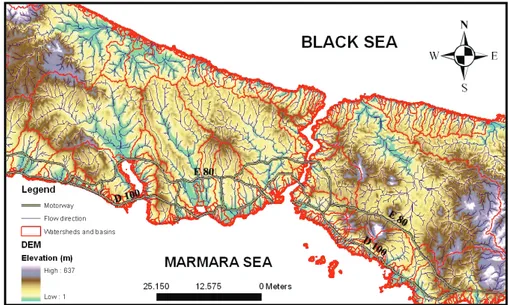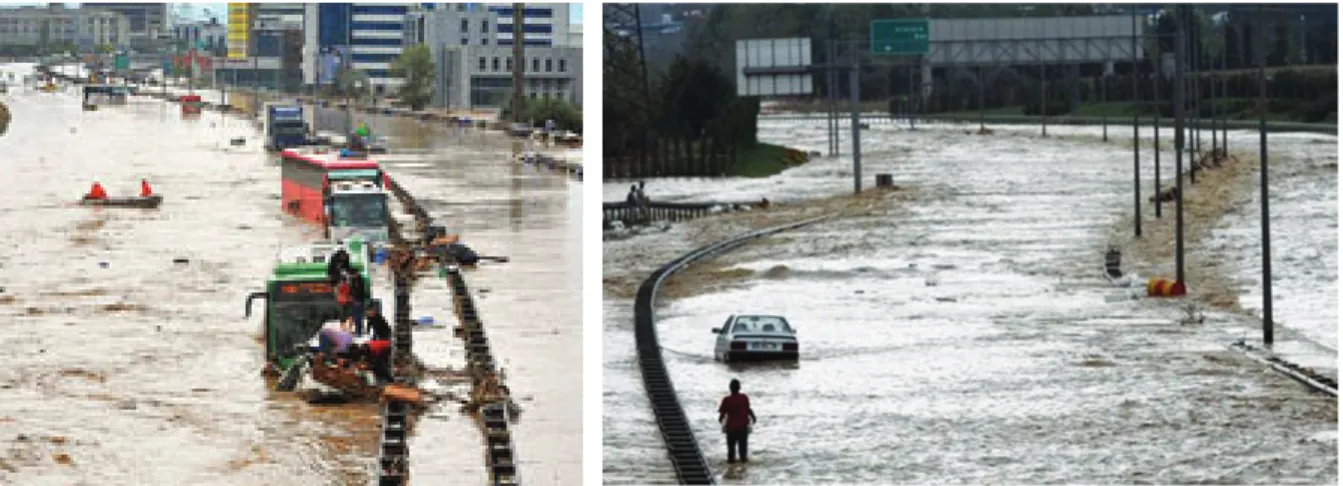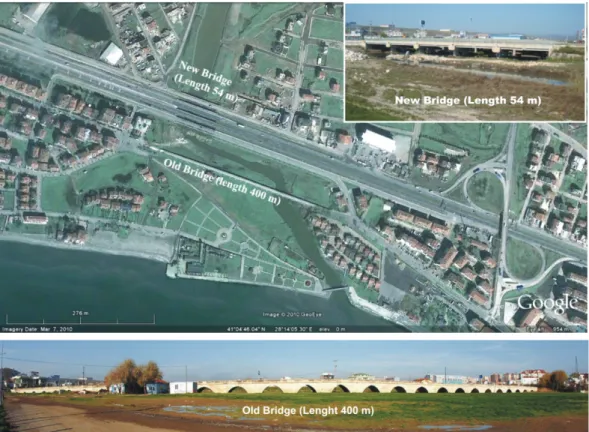Ankara Üniversitesi Çevrebilimleri Dergisi Cilt: 3, Sayı: 1, Haziran 2011, 39-46
Flashfloods and Floods in Istanbul
İstanbul’daki Sel ve Taşkınlar
Hüseyin TUROĞLU
∗İstanbul University, Faculty of Letters, Department of Geography, İstanbul
Abstract: The city of Istanbul has been increasingly suffering from flashfloods and floods leading to loss of life and property for the last few decades. In this study, the causes of flashfloods and floods occurring in Istanbul were investigated from the perspective of the natural drainage system and urban development. Using Remote Sensing (RS) and Geographic Information Systems (GIS) technology, the natural flow accumulation, flow directions based on current slope characteristics, and contemporary aspects of the city were determined. Current constructions, and the characteristics of their distribution in Istanbul, were then associated with the results of the analysis. Constructions in Istanbul have played a major role by changing the natural character of the natural flow accumulation and flow direction, blocking the runoff, reducing water loss, and increasing the flow rate. Due to this, extraordinary rainfall occurring in Istanbul and its close vicinity causes flashflood and flood disasters directed and channelled by the many forms of construction in the city. To prevent future disasters or reduce their damage, the following solutions can be suggested. That all constructions interfering with the surface flow must be reclaimed with revised planning applications. The water-carrying capacity of drainage channels must be restored to their natural levels. That additional drainage channels taking into account natural slope conditions should be built. That aggregation of a huge water body which will cause flashfloods and floods must be prevented by means of a single channel.
Key words: Flashflood and flood, Istanbul, Urban development, GIS and RS.
Özet: İstanbul, son birkaç 10 yıldan bu yana, can ve mal kayıplarına neden olan sel ve taşkınlardan giderek daha fazla zarar görmektedir. Bu çalışmada; İstanbul’da meydana gelen sel ve taşkınların sebepleri drenaj sistemi ve şehirleşme perspektifinde araştırılmıştır. Uzaktan Algılama (UZAL) ve Coğrafi Bilgi Sistemleri (CBS) teknolojileri kullanılarak güncel eğim özelliklerine dayandırılan doğal akım birikimi, akım yönü ve güncel şehirsel özellikler belirlenmiştir. İstanbul’daki mevcut yapılaşmalar ve onların dağılış özellikleri analiz sonuçları ile ilişkilendirilmiştir. İstanbul’daki yapılaşmalar; doğal akım birikimi ve akım yönü özelliklerinin doğal karakterlerini değiştiren, yüzeysel akışı engelleyen, su kayıplarını azaltan, akış hızını arttıran bir faktör olarak önemli rol oynamaktadır. Bu etkiler nedeniyle; İstanbul ve yakın çevresindeki sıradışı yağışlar, şehirsel yapılaşmaların denetlediği ve yönlendirdiği sel ve taşkınlara neden olmaktadır. Gelecekteki afetlerden korunmak ya da onların zararlarını azaltmak için şu çözümler önerilebilir. Su akışını engelleyici tüm yapılaşmalar revise plan uygulamaları ile ıslah edilmelidir. Drenaj kanallarının su taşıma kapasiteleri onların doğal seviyelerine gelecek şekilde yeniden düzenlenmelidir. Doğal eğim koşulları dikkate alınarak ilave drenaj kanallarının yapılması ile sellere ve taşkınlara neden olacak su kütlesinin tek kanalda toplanmasının engellenmesi gerekmektedir.
Anahtar Kelimeler: Sel ve taşkın,İstanbul, Şehirsel gelişim, CBS ve UZAL.
1. Introduction
Due to its historical, geographical, social, and economic characteristics, Istanbul is one of the most important cities not only in Turkey but also the world (Figure 1). Flashfloods and floods cause serious damage to this city. Between the years of 1989-2009, flashflood and flood disasters causing
∗
loss of life and property in Istanbul have occurred 59 times. Because of precipitation of between 185-225 kg/m2 that occurred in the Istanbul region, the flashflood and flood disaster of September 8-10,
2009 was one of the major disasters in recent years for Istanbul. 26 people died in this flashflood and flood disaster. In addition, five people died in the city of Tekirdag during a flashflood caused by heavy rainfall and 9 people were lost during the same flashflood in the region. Furthermore, property damage to a large number of residential homes and workplaces, and erosion and distortion in agricultural areas, have all occurred due to flooding under conditions of heavy rainfall.
In this study, two basic questions concerning flood and flashflood disasters in Istanbul have been investigated from a different perspective. The first question is: “How will natural flow accumulation and flow direction increase under current slope conditions in Istanbul?” The second question is: “What is the interaction between current surface drainage characteristics and urbanization?”
In order to answer these two questions, Geographic Information Systems (GIS) and Remote Sensing (RS) technologies were used as the research method of this study. Satellite images and 1 / 25 000 scale topographic maps were used to create a GIS digital database. In addition, drainage systems and land-use characteristics were derived from field studies. The results were then evaluated by overlay in GIS.
2. Urban Development of Istanbul City
Istanbul's urban development has always been under the limiting and guiding influence of the city's geographical features, namely, the land and seas surrounding it. This effect still continues. The Istanbul Strait, running in a roughly north-south direction, is a natural waterway. The first center of the city was founded on a location called the “historical peninsula” at the southern end of the Istanbul Bosphorus Strait. The city then widened to encompass not only both sides of the Bosphorus Strait but also areas to the east and west of the Bosphorus. The urban area, which is shown in rectangular form, is limited to the north and south by the Black Sea and Marmara Sea acting as natural barriers (Figure 1). Taking place on link roads between Asia and Europe has played important role on urban development of the Istanbul city. Due to these features, the general direction of all constructions which are the natural result of urban development in Istanbul have been planned and applied in an east-west direction (Anonymous 2009) (Figure 1).
3. Natural Flow Accumulation and Flow Directions in Istanbul City
The natural flow accumulation and flow directions of the Istanbul region were determined using RS and GIS technologies. In this study, stereo ASTER satellite imagery for the years 2000-2006 and 1 / 25 000 scale topographic maps in 2.5 m spatial resolution for the coastal regions were used. In addition, GoogleEarth was also used to gather current distribution data for urban constructions.
GIS technologies provide important advantages for hydrologic analysis (Jenson and Domingue, 1988; Maathuis and Wang, 2006; Schäuble et al. 2006; Li et al. 2008; Turoğlu, 2008; Orlandini and Moretti, 2009). Accordingly, GIS was used for determining natural flow direction, calculating natural flow accumulation, and delineating natural watersheds of the Istanbul region and close vicinity. GIS data were analyzed to create layouts for a Digital Elevation Model (DEM), Flow Direction, and Flow Accumulation graphics (Figure 2 and 3).
Figure 2. Watershed and river basin features of study area. Figure 3. Natural flow direction features in study area.
4. Hydrological effects of urban development on flashfloods and floods in Istanbul city
As a general principle, constructions which are a natural consequence of urban development play a role in increasing not only the occurrence but also the frequency and severity of flashflood and flood disasters. Incorrect land-use and preferences cause even more growth of these problems (Mahato, 2001; Konrad, 2002; Konrad and Booth, 2002; Rowsell et al. 2005; Gregory et al. 2006; Turoğlu, 2007; Anonymous 2008; Li et al. 2008; Price and Vojinovic, 2008; Wheather and Evans, 2009; Turoğlu, 2010a; Turoğlu 2010b; Turoğlu and Uludağ, 2010; Zhou, et al. 2011).
Istanbul's highway transportation network lies in an east-west direction (Figure 4). All sorts of construction projects have been implemented in accordance with this east-west approach. However, the natural flow accumulation and flow direction in the Istanbul region lie roughly in a north-south direction. The natural flow direction in the north part of Istanbul is towards the north, and rivers in the northern part of Istanbul flow and discharge into the Black Sea. Flow direction in the southern part of Istanbul is towards the south, and rivers in this region flow and discharge into the Marmara Sea (Figure 2, 3 and 4). Constructions in Istanbul constitute vertical barriers against the surface flow for natural flow accumulation and flow directions by cutting across them longitudinally. Thus, constructions in Istanbul have prevented the natural surface flow and/or changed the natural flow direction.
When results obtained regarding natural flow directions, flow accumulation, and river basins identified using the RS and GIS analysis are compared with existing surface drainage systems in the study area, significant differences are clearly seen. Water falling as precipitation will use the existing slope conditions, in other words, the natural flow directions of Istanbul. In this case, the existing
artificial drainage systems, which are different from the natural flow direction, cannot drain the water coming with extraordinary rainfall. This is one of major causes of flashfloods and floods in Istanbul. Because of urban development, the existing artificial drainage systems in Istanbul city have been made by changing river courses from their natural direction and channel sections. The channel cross-section, reduced by filling, does not possess the capacity of natural rivers and has far less water- carrying capacity.
The main arterial motorways D100 and E80 were planned and built to cut vertically into the natural flow direction. Link roads between the E80 and D100 motorways were constructed on both the valley floor and following the lowest lineaments of the valley floor. In this case, the main arterial highways hinder surface flow, and the link roads act as natural flow channels. The rain water coming with exceptional rainfall, reaching huge volumes, does not flow into the present artificial drainage systems but prefers to flow according to existing slope conditions and on roads (Figure 4, 5 and 6).
Changes to the natural slope conditions that have arisen from urban development in Istanbul have caused puddles of rain water to reach huge volumes and turn into urban floods. The pipes and box culverts, bridges and underground drainage, constructed for water runoff in Istanbul, are either inadequate to discharge the collected water or do not work because they are clogged or defective (Figure 6, 7, 8, 9).
Figure 4. Surface runoff features and D100 and E 80 motorway routes in Istanbul region.
Figure 5. Drainage system of Ayamama River
(picture A and B) and link road between E80 and D100 motorways. In Picture A, the main channel of Ayamama River was moved westward and artificially closed the western slopes of the valley. Picture B represents an overlay of the natural flow accumulation and flow direction with the link road between the E80 and D100 motorways in the Ayamama River basin.
Figure 6. Main roads served as drainage channels (Ayamama River basin, “Basın Expres” link road, September 9, 2009).
Figure 7. Filling under D 100 Motorway in Tuzla valley bottom
and pipe culverts. Figure 8. Both pipes and box culverts are insufficient to handle the surface flow.
Hastily-erected constructions are the other important reason for the occurrence of flashfloods and floods in Istanbul. During extraordinary precipitation, these constructions, which completely block the coast and do not allow runoff to discharge into the Marmara Sea, have been a significant triggering factor for urban flashfloods and floods in Istanbul (Figure 10). These constructions, between the D100 motorway and Marmara Sea, have not only created an artificial barrier and modified natural slope features, but also created a small artificial basin within each site (Figure 4, 5 and 10). Because of the slope and elevation characteristics, roads between the constructions have acted as natural stream channels for surface runoff during extraordinary precipitation (Figure 10).
Figure 9. There are two bridges in the same location on the D100 motorway. The older one was built by Mimar Sinan c.
1560. The second bridge was constructed in the last decade.
Figure 10. Buildings on the shoreline prevent surface runoff from the catchment area into the Marmara Sea (Marmara Sea
coast of Istanbul, September 9, 2009). 5. Conclusions and Recommendations
According to data obtained from this study, flashfloods and floods in Istanbul must be expected as very normal events. From time to time, extraordinary rainfall falls in Istanbul. Constructions carried out without taking into consideration natural environmental conditions are the most important factors in the occurrence of flashflood and flood disasters in Istanbul. Alterations to natural slope features due to construction have changed the natural flow direction. Highway and motorway constructions have not only prevented surface flow but also played an effective role in increasing the frequency and severity of flashfloods and floods in Istanbul. Stream reclamation projects are insufficient and
ineffective in controlling the runoff. Due to urbanization in Istanbul, the slope changes have caused modifications to the natural flow accumulations and flow directions in catchment basins.
In order to prevent and mitigate flashfloods and floods occurring in Istanbul, some recommendations may be made, as follows:
• Restoration projects must be carried out on all constructions blocking natural surface flow. ¾ Culverts on motorways and constructions hindering natural surface flow must be renovated. ¾ Intersections and crossings contrary to the natural flow direction must be adapted to water
discharge.
• The water-carrying capacity of the drainage system must be enlarged to an adequate level by taking into account the natural flow accumulation features and flow directions of the Istanbul region.
• Both water accumulation areas and flow directions should be determined taking into account existing slope conditions. Istanbul Creek reclamation projects should be based on these principles.
• The water-carrying capacity of drainage systems needs to be brought up to a sufficient level taking into consideration the river basin size and natural flow accumulation features in Istanbul.
• The huge volumes of the accumulated water in river basins such as Ayamama stream, Whisk Creek, Alibeyköy Creek, Kagithane Creek, Ayvali River, River Tuzla, Pendik Creek, Kucukyali River, Boston Creek, Kurbağlı River, Küçüksu Creek, Beykoz Creek, etc., which present flood and flashflood hazards, can be prevented by opening additional water drainage channels.
• Infrastructure drainage systems in Istanbul need to re-examined and renovated if necessary. They must also be kept in full working order.
• Longshore land-use planning of the Istanbul-Tekirdağ and Istanbul-Tuzla coastline should be revised taking into consideration hydrologic analysis data.
References
Anonymous 2008. Urban Flood Risk Management. A Tool for Integrated Flood Management. The Associated Programme on Flood Management, 2008. APFM Technical Document No: 11. Flood Management Tools Series. http://www.apfm.info/ ( 05 March 2011).
Anonymous 2009. 1/100.000 Ölçekli İstanbul Çevre Düzeni Plan Raporu. İstanbul Büyükşehir Belediyesi, İmar ve Şehircilik Daire Başkanlığı, Şehir Planlama Müdürlüğü, İstanbul.
Jenson, S. K., Domingue, O. 1988. Extracting Topographic Structure from Digital Elevation Data for Geographic Information System Analysis. Photogrammetric Engineering and Remote Sensing, 4(11):1593-1600.
Gregory, J. H., Dukes, M. D., Jones, P. H., Miller, G. L. 2006. Effect of urban soil compaction on infiltration rate. Journal of
Soil and Water Conservation 61(3):117-124.
Konrad, C. P., 2002. Effects of Urban Development on Floods. US GEOLOGICAL SURVEY Fact Sheet 076-03. http://pubs.usgs.gov/fs/fs07603/ ( 05 March 2011).
Konrad, C. P. and Booth, D. B. 2002. Hydrologic Trends Associated with Urban Development for Selected Streams in the Puget Sound Basin, Western Washington. Tacoma, Washington, U.S. Geological Survey, Water-Resources
Investigations Report 02-4040, Tacoma, Washington.
Li, J., Zeng, B., Wang, Y. and Shen, L. 2008. Physical simulation of urban rainfall infiltration. Journal of China University of
Mining and Technology 18 (2): 293-295, 304.
Maathuis, B. H. P. and Wang, L. 2006. Digital Elevation Model Based Hydro-processing. Geocarto International 21 (1):21-26.
Mahato, M. 2001. Using GIS to Evaluate the Effect of Landuse on the Health of the Upper Trinity River Watershed. http://www.geog.unt.edu/~jminhe/Teaching/GIS-Inter/TermProjects/Mahato.pdf (18 December 2010).
Orlandini, S. and Morett,i G. 2009. Determination of surface flow paths from gridded elevation data. Water Resource
Price, R. K. and Vojinovic, Z. 2008. Urban flood disaster management. Urban Water Journal 5(3):259-276.
Rowsell, P. E., Floyd, P., Ramsbottom, D. and Surendran, S. 2005. Estimating Injury and Loss of Life in Floods: A Deterministic Framework. Natural Hazards 36:43–64.
Schäuble, H., Marinoni, O. and Hinderer, M. 2006. A GIS-based method to calculate flow accumulation by considering dams and their specific operation time. Computers & Geosciences 34 (6):635-646.
Turoğlu, H. 2007. Flood and Flash floods analysis for Bartin River Basin (Turkey). International River Basin Management
Congress, Proceedings: 0-14, 22-24 March 2007, Antalya, Turkey.
Turoğlu, H. 2008. Coğrafi Bilgi Sistemlerinin Temel Esasları. Çantay Kitapevi, Istanbul.
Turoğlu, H. 2010a. 8-10 Eylül 2009 Tarihlerindeki yağışların Silivri-Selimpaşa sahil kuşağında neden olduğu sel ve taşkınlar. DSI Genel Müdürlüğü, 2. Ulusal Taşkın Sempozyumu Tebliğler Kitabı:31-43, 22-24 Mart 2010, Afyonkarahisar. Turoğlu, H. 2010b. Yapılaşmanın Doğal Akım Yönü ve Akım Birikimi Üzerindeki Etkileri (The impacts of structuring on
natural flow direction and flow accumulation). Ankara Üniversitesi Türkiye Coğrafyası Araştırma ve Uygulama
Merkezi, VI. Ulusal Coğrafya Sempozyumu Bildiriler Kitabı: 29-36, 3-5 Kasım 2010, Ankara.
Turoğlu, H. and Uludağ, M. 2010. Floods and Flashfloods in Edirne (TURKEY). 10th International Multidisciplinary
Scientific GeoConference-SGEM 2010, Conference Proceedings Volume II: 9-14, 20-26 June 2010, Albena,
Bulgaria.
Wheather, H. and Evans E. 2009. Land use, water management and future flood risk. Land Use Policy 26S: S251-S264. Zhou, H., Wang, J., Shi, P., Zheng, J., Gao, L., Su, X. and Yuan, Y. 2011. Impacts of rapid urbanization on river network and
flood hazard in Shenzhen region, China. Strategy and Implementation of Integrated Risk Management: 34-39. http://adrem.org.cn/Faculty/
ShiPJ/articals/Impacts%20of%20rapid%20urbanization%20on%20river%20network%20and%20flood%20hazard %20in%20Shenzhen%20region,%20China.pdf (20 March 2011).




